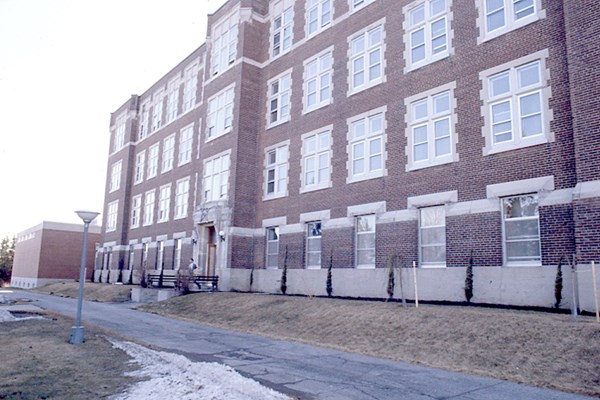Its dark brown bricks on the northwest corner of Yonge Street and Bloomington Road have been a landmark for more than a century, but a new heritage designation for the former De La Salle College building, now owned by the Province of Ontario, will ensure its dark history is not soon forgotten.
The provincial building, which began life as a religious seminary before it was turned into a facility for men with developmental disabilities under the name “Pine Ridge” is set to receive a new heritage designation at Aurora council, one which speaks to the horrors experienced inside by many residents.
Residents Len Bulmer and Kathy Kantel have been two of the leading voices behind recognizing the full extent of the building’s history.
In passionate delegations to council and Aurora’s heritage advisory committee, they outlined the brutal treatment experienced by males 16 years of age and older while living in the building, treatments that were the subject of a $35-million settlement for survivors of the Huronia Regional Centre, under which Pine Ridge operated.
“Institutions for people as we describe today as having ‘developmental disabilities’ have existed for over 130 years in Ontario, from the opening of the first asylum in 1876 to the closing of the final three facilities in 2009,” said Brashanthe Manoharan, heritage planner for the Town of Aurora, in a report to council. “While the intention of these facilities was to promote health, support services, and other aspects of well-being, it was ultimately determined that the institutionalization of people with disabilities was not the best approach as it contributed to isolation, stigmatization and abuse.
“In December of 2013, the Ontario Superior Court of Justice approved a $35-million settlement between the survivors of Huronia Regional Centre and the Ontario government. Shortly after, the Ontario government issued a formal apology to the former residents of Huronia Regional Centre, recognizing that the residents of this institution endured forcible restraints, were stripped of their dignity, and underwent physical and emotional abuse.”
While the current heritage designation enjoyed by the Pine Ridge building emphasizes its role as a Catholic seminary, underscoring its unique Monk’s Walk feature on site, the new designation, which was set to be approved at council last week, will highlight a history that some would have preferred forgotten.
The designation reads as follows:
“In 1950, the property was purchased by the Government of Ontario and the building was converted into a residential facility for males 16 years of age and older with developmental disabilities due to overcrowding at the Huronia Regional Centre in Orillia. The facility was re-named Pine Ridge in 1974 and continued to operate until August 1984. During these years, residents were victim to emotional, physical and psychological abuse instead of receiving the care that these residential institutions claimed to have provided. The building housed over 170 residents, until its closure in August of 1984.”
A commemorative plaque would be placed on the site “at the owner’s cost,” wording for which will be drafted later.
“We know it is not easy to acknowledge difficult history,” Bulmer told lawmakers this past spring, “but we know that not acknowledging this difficult history means repeating it. We have survivors of that institution living right here still in the community. They are among the most vulnerable among us. Not acknowledging what happened to them erases their experience. We believe in cultural and heritage preservation, not erasure.”
An account penned by survivor Martin Levine was also shared by Kantel.
He stated, “They stripped me, took all my clothes off. They led you down on a stretcher, tied your body down tight across your chest, so you couldn’t move. Tight across your legs. Then they rolled you down the hall, you were all tied down and they would take you right into the shower. Then, while you’re all tied down, not able to move or get away, you would suddenly have the freezing cold water come down on you. You were freezing and you couldn’t move. Cold. Naked. Soaking wet and restrained on the bed. Then they’d yell, ‘what do you think of this now? Do you want to apologize to us now?’ After that, then they put you in the side room in isolation. They would leave you just shivering. Everyone could look to the window at you all naked lying on the floor. You didn’t even get fed when you were in the side room like that. That is what they did to you there. One day, staff came in. He was slurring, I could see he was drunk by the time he was talking. The Head Supervisor was the same. He was angry, he grabbed me, had me undressed and put me in the side room. It wasn’t good. Some things I just don’t talk about too much. I think I’ll stop that part there. That’s enough for now.”
Brock Weir is a federally funded Local Journalism Initiative reporter at The Auroran

